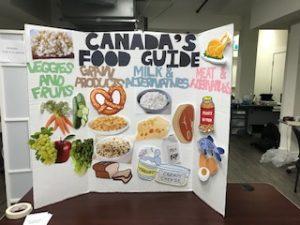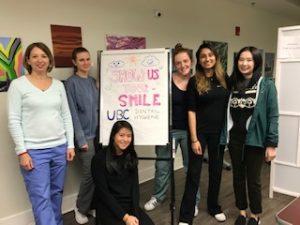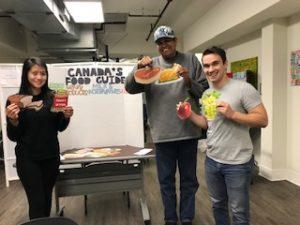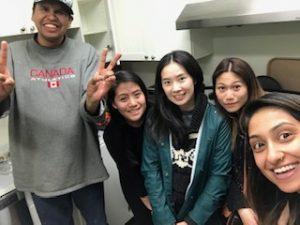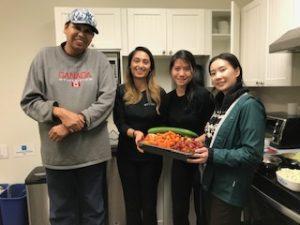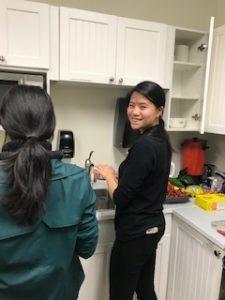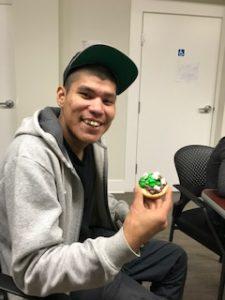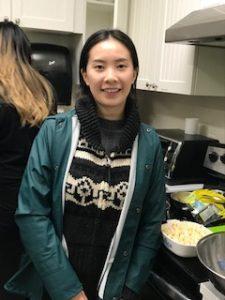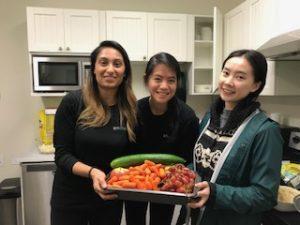This is the November blog post by Inclusive Community Artist-in-Residence Lindsay Wong. For more information on Lindsay’s residency, click here.
Hellen Keller once said, “Alone we can do so little; together we can do so much.” This is also true when storytelling workshops can be merged into teaching tools for health, nutrition, and dental hygiene. In writing practice, one always assumes that a writer works obsessively in solitary confinement until publication, yet it’s a myth that a manuscript goes unedited, unchecked, and unprocessed. In reality, a manuscript undergoes more than a hundred rounds of feedback, all given from the writer’s literary friends, an agent, the in-house editor, the publisher, and the copy-editor before it’s placed in the capable hands of a book-cover designer and publicist. It takes a devoted team to transform a manuscript into book form. And like all artistic practices and programs, it requires intense collaboration, trust, and a tremendous belief in the talents of each party.
Group work, especially one that involves strangers with a diverse set of experiences, backgrounds, and skill sets, can transform a basic storytelling workshop into a session that benefits all workshop participants and JHS clients, particularly during a holiday season that promotes copious consumption of calories, unhealthy fats, refined sugar, and excessive alcohol consumption.
***
This month, at the Community Services Office at JHS, I’ve been asked to collaborate with student nutritionist Christina and the UBC student dental hygienists to host workshops on healthy eating and the effects of overindulging in processed sugar.
Our workshop participants sometimes struggle to understand nutrition labels and some of them are unaware of what constitutes healthy or less-healthy food choices. Holiday food, while delicious, is unfortunately not intended for binge-eating. This is a fact that I also tend to conveniently forget: Did I just eat the entire tray of gingerbread cookies? If I have a hot chocolate with fancy marshmallows, does it still count as one dessert? Is eggnog even real
food?
Christmas parties test my self-discipline, in which Christina told me think about how much exercise/physical output I’d have to complete in order to “shed off the unwanted calories.” Meanwhile, some of our workshop participants struggle to control their diabetes while others don’t yet know correct techniques for flossing or brushing their teeth. Some participants don’t want to bother. For our workshop, Christina printed out Canadian food guides and the dental students brought in colouring pages to reinforce the effects of sugar on one’s teeth and overall
health.
“I love candy,” I admitted, and Eva, one of the student hygienists laughed. “Me too. Just remember moderation and flossing,” she said.For the nutrition workshop, UBC student dental hygienists carefully chopped up white cheddar
cheese into cubes, and washed and sliced globular red apples. Together, we arranged grapes, pretzels, and raisins onto plates and bowls. We engaged the help of one of my regular workshop participants, Perry, who agreed to make popcorn with us in the Community Kitchen.
Participants were then allowed to help themselves to a table of healthy and less-healthy options. As we sat down to eat, Christina thoroughly explained the four food groups: Vegetables and Fruits, Grain Products, Milk and Alternatives, and Meat and Alternatives. She compared the labels on bags and boxes to her nutrition guides.
“This is an okay snack,” she said, pointing at the pretzels. “It’s mostly carbohydrates, which are good for you in moderate amounts. Raisins and apples are examples of foods that are even better for you. It’s important to look at the labels and consider the sugars and fats. You need all the food groups to be healthy. Perry, do you think transfats are good fat or bad fat?” Perry shook his head and replied, “Bad,” which received a round of applause from everyone at the table.
Each workshop participant was then given a challenge: they were supposed to categorize certain foods on a poster board and upon successful completion, they were cheered on loudly by all. There was a sense of camaraderie between workshop participants and the student dental hygienists, who patiently explained cavities and correct oral hygiene whenever sometime asked for clarification.
“My teeth really hurt,” Brent said, after his dental cleaning.
“That’s the worst,” I said, sympathetically. “I never want to eat everything right after I go to the dentist.”
***
Recently, I was thanked for my workshop contributions at a CACV meeting, yet I cannot take any credit, especially as we all work towards serving the JHS community for Christmas. Lacking a network of family or friends, several workshop members experience the loneliness of the festivities as retailers broadcast images of celebrations, Christmas cheer, and present exchanges under festive trees. The holidays are reminders of dispossession and lack of wealth: billboards and television advertisements blatantly offer the assumption of financial stability that everyone should be able to give lavish presents to loved ones, and that invitations will be issued to attend family dinners. However, at JHS, the reality is that many clients will spend Christmas day alone or on the streets.
My neighbours and workshop participants exude anxiety–they repeat narratives of travel plans for visiting movie sets in Hollywood and travelling to exotic locales, even meeting on-line girlfriends and getting married in upscale locations–and yet as JHS staff nod compassionately and continue to ask genuine questions–we know that these spoken accounts are fictions. These narratives are both hopeful and sad–these stories are what workshop participants sweetly and stubbornly repeat to themselves and listeners to feel as if they belong to the mainstream
population.
“I am going to New York City tomorrow,” Gerald, a homeless man who lives on East Hastings, told me. “I’m a full-time actor and we have to work throughout Christmas. I’m starring in a movie and you can watch it on Netflix. This will be my sixth action movie this year with Bruce Willis.”
***
This month, as we move into survival mode at the JHS for Christmas, Boa and the student dental hygienists attempted to reinvigorate spirits while reinforcing healthy eating and proper dental habits.
“What are you eating for Christmas, Lindsay?” Perry asked me, reaching for an apple slice and a handful of fresh popcorn.
“Probably a roast pig,” I said. “My family usually has a pig instead of turkey. What about you?”
“I’m not going to eat sugar because Christina said it’s bad for me,” he said, nodding and smiling contentedly.
***
In art and in real life, collaboration takes multiple forms, sometimes merging interdisciplinary knowledge and backgrounds to create successful products to serve the community. Think of Ernest Hemingway and editor Maxwell Perkins, Golfer Tiger Woods and caddy Steve Williams. Zelda Fitzgerald and F. Scott Fitzgerald were brilliant collaborators, and so were Paul McCartney and John Lennon.
Only by bolstering morale, encouraging workshop participants to focus on their physical and mental health, can we begin to navigate the cruel difficulties and hurdles of the Christmas season.
*Names have been changed to protect the identities of the workshop participants, student dental
hygienists and nutritionist.
